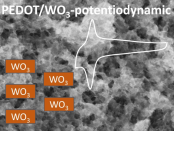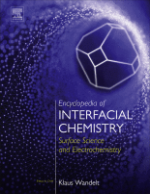
Insights on the electrodeposition mechanism of tungsten oxide into conducting polymers: Potentiostatic vs. potentiodynamic deposition
The paper authored by D. V. Zhuzhelskii, E. G. Tolstopjatova, A. I. Volkova, S. N. Eliseeva,
G. G. Láng
and V. V. Kondratiev
is published in Synthetic Metals (2020, vol. 267, p. 116469).
Abstract:
In this work we have investigated the electrochemical deposition of tungsten oxide into different conducting polymer films from the metastable acidic solution of isopolytungstate. Two different in the nature conducting polymer (CP) materials, namely, poly-3,4-ethylenedioxythiophene (PEDOT) and poly-3,4-ethylenedioxypyrrole (PEDOP) were used as electrode substrates for electrodeposition. Electrodeposition of tungsten oxide into freshly prepared conducting polymer films was performed by two electrochemical methods: potentiostatic and potentiodynamic. The electrochemical behavior of CP/WO3 composites, obtained with variation of synthesis conditions, was investigated by cyclic voltammetry in 0.5 M sulfuric acid. The comparison of electrochemical properties of composites allows to conclude on the mechanism of WO3 deposition. It was shown that precipitates of WO3 in CPs, electrodeposited by potentiodynamic method, display very symmetrical and sharp peaks of the redox transformation of WO3, which are rarely reported for tungsten oxides.
The effect of electrochemical deposition method on the growth of WO3 precipitates on conducting polymer film electrodes and the electrochemical properties of composites was also investigated by combined cyclic voltammetry and electrochemical quartz crystal microbalance (EQCM). The role of polyoxotungstate anion species trapping in CPs during p-doping process and facile formation of tungsten oxide nanostructures in CPs matrix is considered. A mechanism for the electrodeposition of tungsten oxide into PEDOT and PEDOP polymers was proposed.
